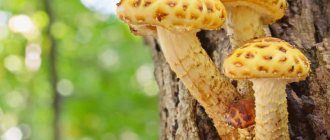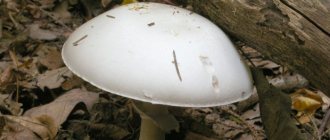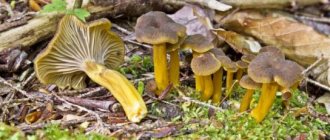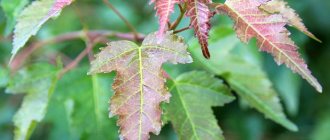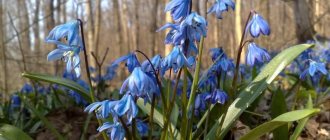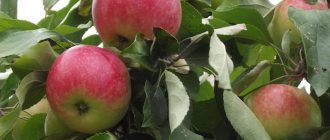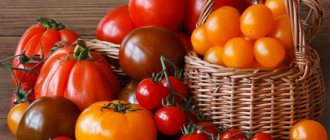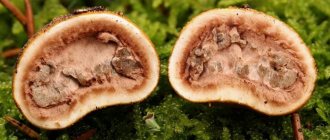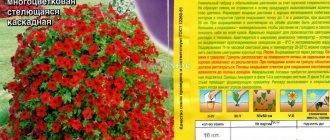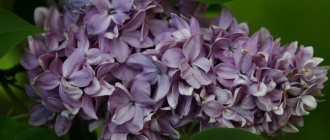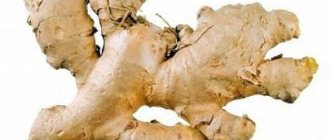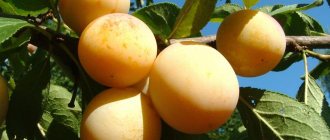Description of the mushroom
The yellow or triumphal cobweb belongs to the genus of cobwebs of the arachnoid family. Latin name: Cortinarius triumphans. You can often find another name for it - triumphal marsh grass.
The mushroom is listed in the Red Book of Moscow and the Moscow region. In other regions of the Russian Federation it occurs quite often and in large groups.
The cap of the triumphal cobweb grows up to 12 cm in diameter, at first hemispherical, then becomes convex, less often flat. The mucous surface is bright, often yellow or ocher in color, becoming reddish or brown with age, lighter at the edges than in the center.
The lower part of the cap is called the hymenophore. In the triumphal web spider it is lamellar, adherent, and the location is frequent. The color when young is bluish, creamy, then becomes more brown, and the edges become lighter. The spores are rusty brown.
The pulp is thick, fleshy, does not change color when cut, the tone is creamy, there is no special taste or smell. An alkali solution causes it to turn yellow.
The leg grows up to 15 cm tall and 2.5 cm thick. Its shape is cylindrical and may expand slightly at the bottom. The color is yellow, covered with clearly identifiable belts in the form of scales.
A little history
In 1838, the Swedish botanist and mycologist Elias Magnus Fries first gave a complete description of it and included it in the genus to which the marsh plant is still classified.
Gallery: types of spider webs (45 photos)
Cortin.triumрhans - has a hemispherical or cushion-shaped, semi-prostrate upper part of an orange-yellow color with the remains of a veil and a sticky or dry surface covering a thick, soft, whitish-yellowish flesh with a pleasant aroma. The plates are of a weakly adherent type, narrow and frequent, light smoky cream or bluish-brown in color with rusty-red-brown spore powder. The lower part of the fruiting body is strongly thickened and cylindrical in shape.
Cortin.alboviolaceus - has a rounded bell-shaped, convex or convex-prostrate cap with an elevation in the central part and a silky-fibrous, shiny, smooth, sticky surface of lilac-violet-silver or white-lilac color. The plates are medium-frequently spaced, narrow, grayish-blue, bluish-ocher or brownish-brown, with the presence of rusty-reddish-brown spore powder. The pedicle area is club-shaped, with weak mucous membrane. The soft part is thick and watery in places
,
gray-blue, brownish, with an unpleasant odor.
Cortin.armillatus - has a hemispherical, gradually opening, cushion-shaped cap with a wide and blunt tubercle in the central part, covered with dry and fleecy, orangeish or reddish-brown color with remnants of a red-orange-brown blanket. The soft part is thick and dense, brownish in color, with a pronounced musty odor and a complete absence of mushroom taste. The plates are of an adherent type, wide and relatively sparsely spaced, grayish-cream, slightly brownish or rusty-brown in color, with brownish-rusty-red spore powder. The lower part of the fruit body is lighter
, with a widening at the base, with bracelet-like remains of the coverlet.
The most special spiderweb
Cortin.rubellus - has a conical or prostrate-conical cap, with a sharp tubercle in the center and a finely scaly, reddish-orange, reddish-orange or bright brownish surface, covering a tasteless and radish-smelling pulp of a reddish-orange-ocher color. Thick and wide plates are sparse, growing to the stem,
orange-ocher or rusty-brown color, with rusty-reddish-brown, spherical, rough spores. The lower part of the fruiting body is cylindrical in shape and of sufficient density.
Dangerous twins
The cobweb family is relatively monotonous; the greatest difference is only in mushrooms that are clearly blue in color; the rest can be confused in one way or another. Whether the yellow spider web is edible or not is something everyone needs to decide for themselves; the important thing is that it is non-poisonous.
| Name | External features | Places and times of growth | Danger |
| Triumphant marsh grass | Yellow cap with a brown center, yellowish leg, with obvious rings | Mycorrhiza forms with birch trees and can be found in conifers. Aug. Sept | Conditionally edible |
| Common spiderwort | The cap is yellow with an olive tint, brownish, very slimy, the leg is white with a purple tint, the belts are weak | Grows with aspen, alder and birch, found in deciduous and mixed forests, rarely in coniferous ones. July - September | Inedible |
| Bracelet web plant | The dry cap is orange in color, may have a reddish tint, covered with dark fibers, the bands on the stem are red-brown | Mycorrhiza forms with birch and pine, preferring more humid places. August - November | Conditionally edible |
| The most beautiful cobweb | The surface of the cap is red-orange, scaly, the stem repeats the shade with the addition of ocher, the bands are lemon-yellow or ocher | Grows in coniferous forests from May to September | Poisonous |
Upon careful examination of a forest find, it will be quite easy to distinguish one spider web from another; if in doubt, it is better to leave the mushroom in place and not take it into the basket.
Evaluation of taste qualities, medicinal properties, benefits and possible harm
Triumphant marsh grass does not have any special taste, but is considered quite edible. Often these gifts of the forest remain in their places and do not end up on the table due to the fact that the fruiting period coincides with the time of appearance of milk mushrooms, boletus and other, more valuable species.
If the yellow cobweb mushroom is in the basket, then it is good both boiled and fried, it can be pickled, dried, frozen and pickled.
Attention! Mushrooms are not recommended for consumption by children under 7 years of age, pregnant and lactating women, as well as during relapses of gastrointestinal diseases.
Yellow spiderwort is not used in folk medicine, but has been shown to have beneficial antiseptic properties.
Distribution and collection
Spider webs grow throughout the Eurasian continent. They can grow among pine trees, but they prefer deciduous ones. Cobwebs are especially often found near birch trees. These mushrooms prefer predominantly dry and bright areas. However, they are also found in swampy areas, which earned them the second name “swampland”.
Cobwebs appear from late summer and grow until the end of September.
Preparation
It is best to eat young mushrooms whose caps have not fully opened. When the spider web becomes old, it acquires a not very pleasant smell that does not go away after boiling or frying. This type can be pickled, fried, prepared as pickles, etc.
Primary processing
The triumphal marsh grass does not require special treatment; it is enough to rinse it under running water and clean it of forest debris and soil. You will also need to remove wormholes and rotten specimens. After this, you can continue to prepare forest gifts.
Cooking
Yellow spider webs should be cooked correctly, in salted water. Salt should be added to taste. Its readiness occurs 15-20 minutes after boiling. Then you should drain the water and use the mushrooms for soup, fry them or freeze them. During the cooking process, foam forms that must be skimmed off.
Pickling
In order to pickle 1 kg of yellow spider webs, you will need:
- salt – 1 tsp;
- sugar – 2 tsp;
- vinegar – 2 tsp;
- dill - 1 umbrella;
- garlic – 2 cloves;
- black peppercorns – 4 pcs.
First you should boil the fruiting bodies for 15 minutes, then continue to marinate according to this scheme:
- Place spices, salt, sugar, and vinegar into prepared jars.
- While still hot, place the mushrooms in containers and pour the marinade over them.
- Cover the jars with lids and turn over until cool.
You can change the spices if you wish, but the presence of salt, sugar and vinegar remains essential. Sweetness gives cobwebs their extraordinary taste, so you shouldn’t reduce the amount of sugar.
Frying
In order to enjoy boiled potatoes with delicious mushrooms, you will need:
- yellow spiderwort – 500 g;
- onion – 150 g;
- vegetable oil – 2 tbsp. l.;
- salt, pepper to taste.
First, boil the mushrooms in salted water, then do the following:
- Fry finely chopped onions in a frying pan with added oil.
- When the vegetable becomes transparent, you can add mushrooms, salt and pepper.
- You don't need to fry the spider web for long, 5-10 minutes is enough.
Serve well as a separate dish or with a side dish - everything will be delicious.
Recipes for the winter
Preparing yellow spiderwort is easy because the process is quite simple. The mushroom does not require soaking and boils quickly. To prepare it for the winter, you will need a little patience and time.
Pickling
Pre-boiled mushrooms are placed in a prepared container, sprinkling each layer with salt. There should also be salt on the bottom and top. For pickling, it is not necessary to use any spices; spider webs are good in their natural form, their taste will be excellent. On top you should put gauze folded in several layers, a plate and press everything down with a weight.
After 2-3 days, the mushrooms will be covered with brine; you need to periodically rinse the gauze or replace it with a new one. This way you can avoid the appearance of mold. After 3 weeks you can try mushrooms.
Many housewives add various spices that improve the taste of salted mushrooms. May be useful:
- Bay leaf;
- dill;
- carnation;
- horseradish and currant leaves;
- garlic and others.
You can use them as you wish, the proportions are also observed at your personal discretion.
Drying
If you want to preserve cobwebs in dried form, then no preliminary boiling is required. It is better not to wash the mushrooms; just clean them from forest debris. After this, string it on a thread and hang it in a sunny, well-ventilated place.
You can dry the fruits in the oven; for this, the oven is heated to 70 degrees, and the marshmallows are placed inside on a baking sheet. They should be turned over periodically to ensure even drying. After 6–7 hours, the mushrooms are removed. The fruiting bodies should be cooled and stored in a closed container. Store in a dark place without foreign odors.
Canning in jars
In order to preserve the marshland, for 2 kg of mushrooms you will need:
- salt – 300 g;
- dill - 3 umbrellas;
- horseradish leaf – 3 pcs.;
- garlic – 3 cloves;
- vegetable oil – 200 ml.
Cooking process:
- Washed and peeled mushrooms should be boiled in salted water for 40 minutes.
- Place the fruits in jars, add dill and garlic to each jar, and place a horseradish leaf on the bottom.
- Pour the broth over everything, add 2 tbsp to each jar on top. l. oils
- Now you can roll it up, cool it and put it in a cool, dark place.
This recipe is very simple, the main thing is that the jars are pre-steamed with boiling water and completely clean.
Interesting Facts
The triumphant cobweb received its name due to its color, which is reminiscent of the golden crown of victorious generals in Ancient Rome.
Mushroom pickers often have to choose between cobwebs and black milk mushrooms, because they grow at the same time, usually nearby, but it is quite difficult to cope with the preparation of two types of mushrooms at once. Usually the choice is not in favor of the marsh-dweller, and therefore he remains in the forest.
The pulp of this mushroom does not change color when broken, but dries out quite quickly. The absence of an unpleasant odor and good taste make the yellow cobweb one of the most delicious of its kind.
When you boil the triumphal web, you often notice that the broth is very clear, the mushroom remains nice and crispy. These advantages make the marsh grass more competitive among the fruits of the autumn forest.
Mushrooms are popular forest fruits that should be collected only if you are completely sure of their edibility. The yellow cobweb is a tasty, conditionally edible specimen; it is easy to distinguish, but if you have the slightest doubt, it is better not to take it. Preparing this species is not difficult, it grows in large families, and therefore a rich harvest is guaranteed.
First aid for poisoning
Typical symptoms of spider web poisoning are: vomiting, a feeling of dry mouth, constant thirst, cramping abdominal pain. If these symptoms occur after eating a mushroom, you should immediately call a doctor. Transporting a patient with suspected mushroom poisoning on your own is dangerous, because some toxins affect the functioning of the heart. While waiting for the ambulance to arrive, you must:
- Perform gastric lavage.
- Give a laxative.
- Give a cleansing enema.
False chanterelles: what are they, can mushrooms be eaten
Then you should put the patient to bed and constantly water him with saline solutions and strong, chilled tea. You should not refuse recommended hospitalization, even if the patient feels better.
To summarize, we can say that collecting cobwebs is not a good idea for inexperienced mushroom pickers . Of course, their edible varieties have a very piquant taste, but a violation of the technology for preparing this product can result in a hospital bed for a person.
